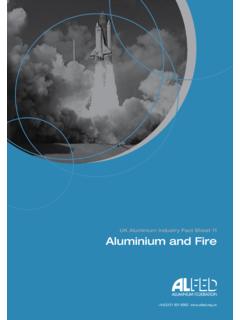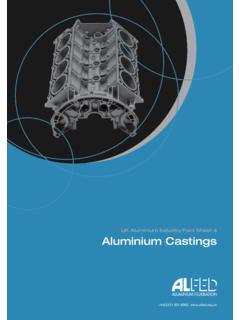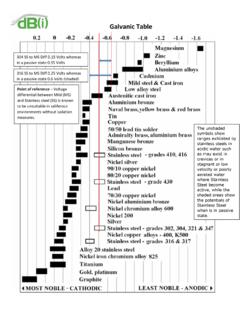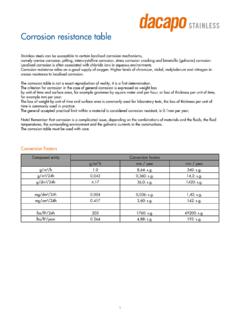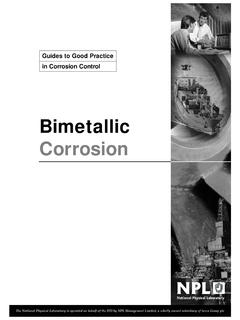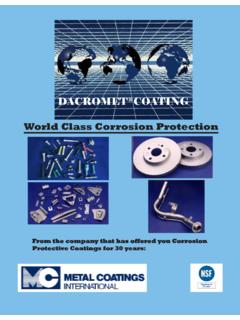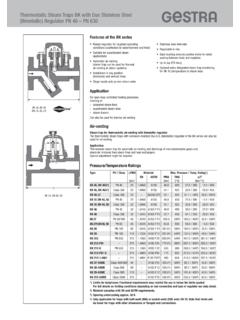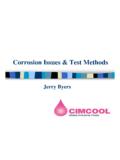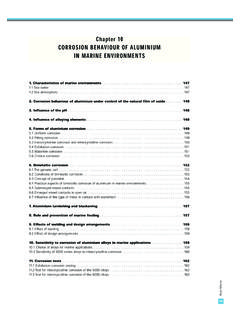Transcription of UK Aluminium Industry Fact Sheet 2 Aluminium and …
1 UK Aluminium Industry Fact Sheet 2 : Aluminium and Corrosion1 Aluminium and CorrosionUK Aluminium Industry Fact Sheet 2+44(0)121 601 6363 UK Aluminium Industry Fact Sheet 2 : Aluminium and Corrosion1 Introduction Although Aluminium is a very reactive metal with a high affinity for oxygen, the metal is highly resistant to most environments and to a great variety of chemical agents. This resistance is due to the inert and protective character of the Aluminium oxide film which forms on the metal surface. In most environments, the rate of corrosion of Aluminium decreases rapidly with time. In only a few cases, caustic soda, does the corrosion rate approximate to the the oxide film is extremely thin, between 50 and 100 Angstroms, it forms a protective barrier between the metal and the surrounding medium as soon as the metal comes into contact with an oxidising environment, such as water.
2 The physical-chemical stability of the oxide film determines the corrosion resistance of the Aluminium . This stability is dependent upon the pH value of the environment, since the oxide film is stable within the pH range of about 4 to 8. Below and above these values, acid dissolution yields Al3+ ions and the alkaline dissolution leads to the formation of Al(OH)4 Aspects of CorrosionReactionsAny corrosion reaction in aqueous solution must involve oxidation (anodic reaction) of the metal and reduction (cathodic reaction) of a species in solution, with consequent electron transfer between the two reactants. The anodic and cathodic reactions occur at the same rate and simultaneously upon a metal s surface, therefore the metal is electrically charged, and thus the rate of oxidation is equal to the rate of reduction.
3 For example in this situation, the corrosion of Aluminium in water may be represented by the two half reactions:-Oxidation (anodic reaction) Al => Al3+ + 3eReduction (cathodic reaction) H+ + e => H2 Uniform AttackThis is a common form of corrosion , where all areas of the metal corrode at a similar rate. Over a period of time, the exposed metal undergoes oxidation by aggressive ions (such as chloride ions), until the metal fails, due to thinning. Uniform attack can be predicted on the basis of immersion tests, weight loss over a period of time. It can be prevented in several ways as described below:-Selection of appropriate materials and/or coatings, non-metallic or metallic anodising. Use of inhibitors, such as chromic acid in the case of Aluminium alloys.
4 Application of cathodic protection, such as sacrificial zinc anodes. Galvanic CorrosionThis type of corrosion occurs when two conducting materials of different chemical composition are joined and exposed to a conducting solution when iron is connected to copper in water. Iron passes into solution as Fe2+ ions and the residual electrons are conducted through to the copper and, as a consequence, hydroxyl ions, 0H- , are formed at the surface. Galvanic corrosion is very damaging because it concentrates on the less noble metal at the metal-metal junction, where deep attack occurs. At the junction a large corrosion current can pass because the electrical resistance of the short path through the electrolyte is forms of metal joining, brazing, welding etc.
5 Provide junctions at which galvanic UK Aluminium Industry Fact Sheet 2 : Aluminium and Corrosion2corrosion can develop. Galvanic corrosion on a microscopic scale can also occur between constituents of multi-phase alloys and of impure metals which contain foreign particles and intermetallic Aluminium is coupled with copper or brass, corrosive attack upon the Aluminium is accelerated by these materials in severe or modest atmospheres and conditions of immersion. Contact between Aluminium and stainless steel (18/8, 18/8/2 and 13% Cr) will only slightly increase the corrosion of the Aluminium in dry atmospheres. However, it is markedly increased in moist atmospheres, particularly in marine simple way of avoiding bimetallic corrosion is to isolate the two metals from one another.
6 This can be achieved by good design and where necessary by inserting an insulating material such as neoprene between the metal/metal contact. This would be important in an application where an Aluminium component is fixed in place with a steel CorrosionIntense localised corrosion , ranging from small pits to extensive corrosion over the whole surface, can occur within narrow crevices that may be formed by:-The geometry of the structure, riveted plates, threaded joints etc. Contact of metal with non-metallic solids, plastics, rubber etc. Deposits of sand, dirt or permeable corrosion products on the metal surface. Differential aeration plays an important part in the mechanism of crevice corrosion , but it is not the sole cause. The situation in reality is far more complex, owing to the formation of acid within the an Aluminium crevice, corrosion makes little progress, probably due to the precipitation of Aluminium oxide, a corrosion product that restricts the entrance to the is a form of localised corrosion that proceeds because of local cell action that produces cavities at the surface.
7 These cavities may become filled with corrosion products. corrosion products can form caps over pit cavities, which are described as nodules. While the shapes of the pits vary widely, they usually are roughly saucer shaped, conical, or hemispherical. Pit walls usually are irregular in profile when viewed under a occurs when a film-protected metal is almost, but not completely, resistant to corrosion , as in the case of Aluminium and its alloys. It usually occurs on a metal surface immersed in a solution or moist environment, such as soil. It can occur on a surface exposed to the atmosphere if there are droplets of moisture or condensed moisture film present on the metal surface. Pitting may also occur in crevices, in which case it is called crevice corrosion (see above).
8 Pitting usually occurs on metals that are covered with a very thin, often transparent, passive oxide film that may form during fabrication or be produced by reaction with the environment. Thus, pitting occurs on magnesium, Aluminium , titanium, stainless steel, and copper in cases in which surface films develop. Pits initiate at flaws within the surface film and at sites where the film is damaged mechanically under conditions in which self-repair will not occur. Most cases of pitting are believed to be caused by local cathodic sites in an otherwise normal a pitted surface is dried out, the pits will terminate. When rewetted, some of the pits may be reactivated. This may be due to the re-establishment of the conditions or to differential aeration between the solution in the main pit cavity and solutions in some of the cracks that emanate from it deeper into the , Aluminium is capable of reacting with a wide range of chemical substances.
9 Free energy considerations make the reactions with oxygen and water particularly favourable. However, Aluminium shows a high resistance to reactions which would result in corrosion in most neutral solutions. This is generally accepted to be due to the rapid growth of oxide films or absorbed oxygen on its surface. The oxide film forms within seconds, is self-healing, has a slow thickening rate and is very compact and adherent. Thus, this acts as a barrier between the metal surfaces, whereas, in crevice corrosion , attack is due to the shielding of a small area of surface from the bulk CorrosionThis form of corrosion consists of localised attack in which a path is corroded preferentially along the grain boundaries of the metal. The mechanism is electrochemical and is dependent upon the formation of local cells at the grain boundaries.
10 The local cells are a result of second phase precipitates UK Aluminium Industry Fact Sheet 2 : Aluminium and Corrosion3at the grain boundaries. During the formation of intermetallic second phase precipitates along the grain boundaries, an adjacent matrix zone is formed that has a different solution potential. The precipitate may be anodic to the matrix such as Mg5Al8, in which case it corrodes preferentially; or it may be cathodic, such as CuAl2, in which case it does not corrode, but stimulates corrosion in the adjacent matrix zone. In either case, selective grain boundary corrosion occurs. The degree of susceptibility of an alloy to intergranular attack can vary depending on its microstructure, in particular, the amount, size, and distribution of second phases, which is a result of the metallurgical history and thermal treatment.
